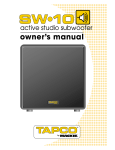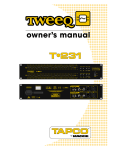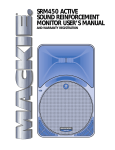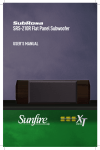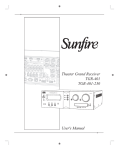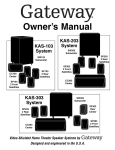Download Gateway SW203 User's Manual
Transcript
Owner’s Manual Model SW103 Model SW203 Model SW303 51/4˝ 100 watt Powered Subwoofer 61/2˝ 200 watt Powered Subwoofer 10˝ 400 watt Powered Subwoofer IMPORTANT SAFETY INSTRUCTIONS 2 The lightning flash with arrowhead symbol within an equilateral triangle is intended to alert the user to the presence of uninsulated “dangerous voltage” within the product’s enclosure that may be of sufficient magnitude to constitute a risk of electric shock to persons. Le symbole éclair avec point de flèche à l’intérieur d’un triangle équilatéral est utilisé pour alerter l’utilisateur de la presence à l’intérieur du coffret de “voltage dangereux” non isolé d’ampleur suffisante pour constituer un risque d’éléctrocution. The exclamation point within an equilateral triangle is intended to alert the user to the presence of important operating and maintenance (servicing) instructions in the literature accompanying the product. Le point d’exclamation à l’intérieur d’un triangle équilatéral est employé pour alerter les utilisateurs de la présence d’instructions importantes pour le fonctionnement et l’entretien (service) dans le livret d’instruction accompagnant l’appareil. THIS DEVICE COMPLIES WITH PART 15 OF THE FCC RULES OPERATION IS SUBJECT TO THE FOLLOWING CONDITIONS: 1) THIS DEVICE DOES NOT CAUSE HARMFUL INTERFERENCE AND 2) THIS DEVICE MUST ACCEPT ANY INTERFERENCES RECEIVED INCLUDING INTERFERENCE THAT MAY CAUSE UNDESIRED OPERATION 1. Read these instructions — Read all the safety and operation instructions before operating the SW103/SW203/SW303. 2. Keep these instructions — Keep the safety and operating instructions for future reference. 3. Heed all warnings — Follow all warnings on the SW103/SW203/SW303 and in these operating instructions. 4. Follow all instructions — Follow all operating and other instructions. 5. Do not use this apparatus near water — for example, near a bathtub, washbowl, kitchen sink, laundry tub, in a wet basement or near a swimming pool. 6. Clean only with dry cloth. 7. Do not block any ventilation openings. Install in accordance with the manufacturer’s instructions. 8. Do not install near any heat sources such as radiators, heat registers, stoves, or other apparatus (including amplifiers) that produce heat. 9. Do not defeat the safety purpose of the polarized or grounding-type plug. A polarized plug has two blades with one wider than the other. A grounding-type plug has two blades and a third grounding prong. The wide blade or the third prong are provided for your safety. If the provided plug does not fit into your outlet, consult an electrician for replacement of the obsolete outlet. 10. Protect the power cord from being walked on or pinched particularly at plugs, convenience receptacles, and the point where they exit from the apparatus. 11. Only use attachments/accessories specified by the manufacturer. 12. Unplug this apparatus during lightning storms or when unused for long periods of time. 13. Refer all servicing to qualified service personnel. Servicing is required when the apparatus has been damaged in any way, such as power-supply cord or plug is damaged, liquid has been spilled or objects have fallen into the apparatus, the apparatus has been exposed to rain or moisture, does not operate normally, or has been dropped. 14. WARNING: To reduce the risk of fire or electric shock, this apparatus should not be exposed to rain or moisture and objects filled with liquids, such as vases, should not be placed on this apparatus. 15. To completely disconnect this equipment from the mains, disconnect the power supply cord plug from the receptacle. 16. The mains plug of the power supply cord shall remain readily operable. 17. Connect the SW103/SW203/SW303 to a power supply of the type described in these operation instructions or as marked on the SW103/SW203/SW303. 18. To prevent electric shock, do not use the SW103/SW203/SW303 polarized plug with an extension cord, receptacle or other outlet unless the blades can be fully inserted to prevent blade exposure. Pour préevenir les chocs électriques ne pas utiliser cette fiche polariseé avec un prolongateur, un prise de courant ou une autre sortie de courant, sauf si les lames peuvent être insérées à fond sans laisser aucune pariie à découvert. 19. Internal/External Voltage Selectors — Internal or external line voltage selector switches, if any, should only be reset and reequipped with a proper plug for alternate voltage by a qualified service technician. This apparatus does not exceed the Class A/Class B (whichever is applicable) limits for radio noise emissions from digital apparatus as set out in radio interference regulations of the Canadian Department of Communications. ATTENTION — Le présent appareil numérique n’émet pas de bruits radioélectriques dépassant las limites applicables aux appareils numériques de class A/de class B (selon le cas) prescrites dans le règlement sur le brouillage radioélectrique édicté par les ministere des communications du Canada. TABLE OF CONTENTS A. UNPACKING . . . . . . . . . . . 3 B. SW103/SW203/SW303 AMPLIFIER PANEL TOUR . 3 C. PLACEMENT . . . . . . . . . . 5 D. SUBWOOFER CONNECTION . . . . . . . . . 6 E. INITIAL LISTENING TESTS & ADJUSTMENTS . . . . . . . 7 F. SPECIFICATIONS . . . . . . . 8 G. TROUBLESHOOTING AND SERVICE . . . . . . . . . . . . . 8 Congratulations on your purchase of a Gateway® SW103/SW203/SW303 powered subwoofer. It will give your stereo system unparalleled low frequency output. Bass frequencies are critical to realistic sound reproduction. After you’ve hooked up your SW103/SW203/SW303 subwoofer, you’ll discover just how much “punch” and depth you’ve been missing. No matter what kind of music or videos you listen to...whether you listen to it loud or soft, you’ll experience sound that’s richer and fuller. Bass guitar and string bass will have more impact. You’ll be able to FEEL as well as hear percussion – just the way you would at a live performance. If you have an audio/video system, movies will come alive with thunderous sound effects that were never possible without the SW103/SW203/SW303. The SW103/SW203/SW303 is a self-pow- ered subwoofer that frees your receiver or power amplifier from the power demands of reproducing very low frequencies. To do this, the SW103/SW203/SW303 incorporates its own built-in crossover system that automatically “assigns” higher frequencies to your main speakers and lower frequencies to its own power amplifier, contained within the subwoofer enclosure. The SW103/SW203/SW303 has been meticulously designed and tested to insure high performance, durability and longevity. This manual is designed to take you step-by-step through the setup and operating process. This procedure is not difficult, but it IS slightly different than setting up a line level component such as a cassette deck or CD player. Reading this manual carefully will insure that you get maximum performance from your SW103/SW203/SW303. A UNPACKING Remove the SW103/SW203/SW303 from its packing carefully and inspect it for any shipping damage. If you discover damage, contact your Gateway® dealer immediately. If possible, save the carton and internal packing. It’s the best possible protection for your SW103/SW203/SW303 if you need to move it or return it for service. Keep your sales receipt in a secure place. It helps establish the duration of your warranty and is good for insurance purposes (just in case anything happens to your stereo system). 3 B SW103 AMPLIFIER PANEL TOUR 1 2 3 4 Before setup, you should familiarize yourself with the connections on the back of the SW103 as shown in Drawing 1. 1. POWER INDICATOR. When the amplifier is ON, this indicator will be green. When the amplifier is in the STANDBY mode, this indicator will be red. 2. VOLUME CONTROL. Rotating this knob clockwise increases the output level of the subwoofer. To start out, make sure that the VOLUME is turned all the way down (fully counterclockwise). Later, after some initial listening tests, you can adjust the volume to your own tastes. However, care should be taken not to overdrive the subwoofer to the point of audible distortion. 3. SUB IN. This connection is used to connect to the subwoofer line output of your receiver. DRAWING 1 - SW103 rear panel 4. REMOVABLE FUSE HOLDER. By pushing in and turning counter-clockwise, you can remove and replace the fuse. Check the rating on the fuse for proper size of your unit. SW203/SW303 AMPLIFIER PANEL TOUR switch is in the AUTO position, the amplifier will stay turned on as long as a signal is being fed to the subwoofer amplifier. 15 to 20 minutes after you stop playing music or a video, the amplifier goes into STANDBY mode – see (1). When you again begin to play music or a video, the amplifier will automatically turn on. Before actual setup, you should familiarize yourself with the connections on the back of the SW103/SW203/SW303, as shown in Drawing 2. 3. PHASE SWITCH. This switch is used to set the subwoofer’s phase to either normal “0º” or reverse “180º” (out of) phase. Once you determine the placement of the SW103/SW203/SW303, you will need to try both positions of this switch for the best bass output for your listening position. The physical location of your subwoofer and main speakers determines the phase setting that will sound best at your main listening position. If this requires using the “180º” mode, don’t worry, there is nothing “abnormal” about it. 1. POWER INDICATOR. When the amplifier is ON, this indicator will be green. When the amplifier is in the STANDBY mode, as mentioned in item 2, this indicator will be red. 4 2. POWER/AUTO ON SWITCH. This toggle switch turns the SW103/SW203/SW303 on and off. When the switch is in the ON position, the amplifier will stay on as long as the switch remains in that position. When this 2 1 10 3 5. CROSSOVER FREQUENCY CONTROL This control determines what lower part of the frequency spectrum will be reproduced by the SW103/SW203/SW303 and what higher parts will be handled by your main speaker. It is a “crossover” control. Rotating the knob sets the point where all lower frequencies will be handled by the subwoofer and all higher frequencies will be routed to your main stereo speakers. As a starting point, set the control around 80 Hz. if you are using left and right tower speakers, 100 Hz. with bookshelf speakers, and 120 Hz. with small mini-speakers. Note: If you use the SUB IN connector, the RECEIVER TYPE toggle switch must be in the Pro Logic mode for the crossover frequency control to operate. 6. SUB IN. This connection is used to connect the subwoofer to the receiver. 7. RECEIVER TYPE TOGGLE SWITCH. You must set this switch to the type of receiver mode you are using. Note: When this switch is set to DIGITAL RECEIVER 5.1, 6.1, 7.1, the CROSSOVER FREQUENCY control (9) does not affect the signal. 4 11 4. VOLUME CONTROL. Rotating this knob clockwise increases the output level of the subwoofer. To start out, make sure that the VOLUME is turned all the way down (fully counterclockwise). Later, after some initial listening tests, you can adjust the volume to your own tastes. However, care should be taken not to overdrive the subwoofer to the point of audible distortion. 5 8. POWER INPUT. This connector is the AC power in. Your subwoofer is supplied with a removable power cord that mates to this plug. 6 9. REMOVABLE FUSE HOLDER. By pushing in and turning counter-clockwise, you can remove and replace the fuse. Check the rating on the fuse for proper size of your unit. 7 9 8 DRAWING 2 - SW203/SW303 rear panel 10. FROM RECEIVER. Connects to a receiver’s speaker terminals. These binding post, color-coded connectors are used to hook the subwoofer to another receiver that may not have subwoofer out or LFE (Low Frequency Effects) output connections. 11. OUT TO SPEAKERS. If you are using the SW103/SW203/SW303 from receiver inputs, you will hook your main speakers to these binding post, color-coded connections. They are NOT used if you are using the LFE (SUB) IN line level connection. 3. Connections to your receiver, integrated amplifier or preamplifier. If your receiver or integrated amplifier does not have a subwoofer output or LFE output (see next page), setup between the amp and SW103/SW203/SW303 will be made with speaker wire. You can basically place the SW103/SW203/SW303 anywhere in a normal-sized room. C PLACEMENT Where to position your SW103/SW203/SW303 The SW103/SW203/SW303 operates at low bass frequencies which are essentially omni-directional. That means you can place the SW103/SW203/SW303 almost anywhere in a room without compromising the effectiveness of your main stereo speakers. Four factors need to be considered: 1) distance from your main speakers; 2) distance from a wall outlet; 3) distance from your receiver; and 4) proximity to walls and corners. 1. Distance from your main speakers. The best placement for your subwoofer is on the same wall as the main speakers, especially if you are matching up with small bookshelf speakers. With tower speakers, side wall or rear placement is also acceptable. 2. Wall outlet. Since the SW103, SW203, and SW303 require AC power, it must be placed within ten feet of a wall outlet. We don’t recommend extending that range with an extension cord. Away from walls: Normal bass Away from walls: Normal bass 4. Proximity to walls and corners. Physical placement of the subwoofer will have a definite impact on the frequency response and the perceived amount of SW103/SW203/SW303 bass output. Because low frequencies have long wavelengths, they are influenced by proximity to a boundary such as a wall or floor. See Drawing 3 below. When you place the SW103/SW203/SW303 well away from a wall, it will produce bass at a certain level. Move the subwoofer close to the wall, it will produce more output (about 3dB more). Putting the subwoofer in a corner will increase output another 3dB (6dB more than when placed away from walls and corners). is no “right” or “wrong” place to put the SW103/SW203/SW303(assuming it’s less than ten feet from a wall receptacle). It all depends on how much bass you want. Another reason to experiment – because low bass waves are very large (up to forty feet or more across!), they tend to cancel and reinforce each other, causing places in the room where there is lots of bass and others where there isn’t very much at all. If you walk around your listening room while playing music, you’ll probably discover these sorts of areas where bass is either exaggerated or reduced. Incidentally, moving the SW103, SW203, or SW303 around won’t affect the stereo imaging of your main stereo system, so feel free to try various subwoofer positions. 5 Connecting the SW103/SW203/SW303 to a wall plug All this technical jargon may sound confusing, but it basically means that you have a number of options, each of which produces a different amount of bass. For example, if you like a lot of heavy bass, consider putting the SW103/SW203/SW303 into a corner. If you like smoother, less-obvious bass, move the subwoofer out into the room. The main thing to remember is that there The SW103/SW203/SW303 draws a moderately high amount of current. We do not recommend plugging it into a “convenience” outlet (switched or unswitched) that is often found on the back of receivers and other stereo components. Instead, connect the SW103, SW203, or SW303 ONLY to its own AC outlet. See items 8 and 9 in the Safety Instructions at the beginning of this manual. Against walls: More bass In Corner: Most bass Against walls: More bass DRAWING 3 - SW103/SW203/SW303 placement In Corner: Most bass SURROUND SOUND RECEIVER D SUBWOOFER CONNECTION See Drawings 4 and 5 Note: Use the RCA to RCA connector cable that was supplied with the speaker system. 6 IMPORTANT: Make sure that ALL stereo system components including the SW103/SW203/SW303 are turned OFF before proceeding. o 1. Locate the subwoofer output connector on the rear of your receiver and connect one end of the RCA line level cord to it. o 2. Route the line cord to the subwoofer location (trying to minimize areas where it may be stepped on) and connect the other end directly to the SUB IN. o 3. Connect your main (and surround speakers if applicable) to the receiver according to the receiver’s owner’s manual. o 4. For the SW203 and SW303, set the RECEIVER TYPE toggle switch to receiver mode you will be using. Note: If you are using a Dolby Digital type receiver, the subwoofer crossover control does not work. You must set the crossover frequency in your receiver (check the receiver’s owner’s manual). o 5. You are now ready to put your SW103/SW203/SW303 subwoofer into use. DRAWING 4 - Setup for SW103 SURROUND SOUND RECEIVER SW203 connection SW303 connection NOTE: SEE ITEM 4 ABOVE FOR PROPER RECEIVER TYPE SWITCH SETTING DRAWING 5 - Setup for SW203 and SW303 E INITIAL LISTENING TEST It’s now time to test the SW103, SW203, and SW303 subwoofer in your listening environment. o 1. Double-check all connections. o 2. Make sure that the volume controls on both the subwoofer and your receiver/integrated amp/preamp are turned all the way down (fully counterclockwise). Set the PHASE switch to normal. For the SW203 and SW303, set the CROSSOVER FREQUENCY knob to 80 Hz. Set the SUB IN switch to the type of receiver mode you will be using. o 3. Turn on your stereo system. THEN turn on the SW103/SW203/SW303. Confirm that the SW103/SW203/SW303’s green POWER indicator is glowing. If it isn’t, check the power connections between the SW103/SW203/SW303 and the wall socket. o 4. Play a musical selection that you are familiar with. Pick a song that has regular low bass beats. Advance the receiver/integrated amp/preamp’s volume control up to a normal listening level. If you don’t hear sound through your main speakers, turn off the system and check connections. Also consult the troubleshooting tips on page 8. o 5. If sound is coming out of your main speakers, turn the SW103/SW203/SW303’s VOLUME control clockwise until you hear noticeable additional bass. If you don’t hear bass by the time you have advanced the subwoofer’s VOLUME control halfway, turn off the system and check connections. Also consult the troubleshooting tips on page 8. o 6. Adjust the SW103/SW203/SW303’s VOLUME control until you are satisfied with the amount of bass. You may want to try several different movies, tapes, compact discs or DVDs while determining how high to adjust the SW103/SW203/SW303’s VOLUME. The amount of bass varies from disc to disc and between different types of music. o 7. While playing music, move the subwoofer around, in and out of corners, closer and farther from the wall, etc. as much as the power cord and other connections will allow. The following steps apply to the SW203 and SW303 only: o 8. Now that you have adjusted the quantity of bass via the volume, it’s time to work on the quality of the bass with the CROSSOVER FREQUENCY control, PHASE switch – and experimentation with SW103/SW203/SW303 room position. o 8a. Change the PHASE switch back and forth from 0º to 180º while someone sits in the main listening position. Leave the switch in the position where you like the bass most. o 8b. Change the CROSSOVER FREQUENCY control (for Dolby Pro-Logic receivers) to higher and lower settings. If the CROSSOVER FREQUENCY control is set too high, you’ll start to hear low midrange (voices and instruments) through it. This will negatively affect the stereo imaging of your main speakers. Back the CROSSOVER FREQUENCY setting off until you hear only bass from the SW103/SW203/SW303. If the CROSSOVER FREQUENCY control is set too low, you simply won’t get much output from the subwoofer. Move it back closer to 80Hz. o 9. After you are satisfied with the output of your SW103/SW203/SW303, you can make all your volume settings through your receiver’s volume control. The only time you might want to re-adjust the SW103/SW203/SW303’s VOLUME is when you encounter a musical selection that has abnormally low – or high – bass. You can leave the SW103 in the ON mode, and your SW203 or SW303 turned on and in AUTO mode when not in use. It does not draw much power in this state and will be ready to add low bass the moment you begin to play music. The SW103/SW203/SW303 will automatically go into STANDBY mode after 10 to 20 minutes, when no music is playing. If you’re not using your stereo system for a long period of time (such as when you’re on vacation), unplug it from the AC wall outlet. Caring for Your SW103/SW203/SW303 The SW103/SW203/SW303 enclosure is finished in a very high quality polymer laminate covering that is both attractive and excellent protection for the wood cabinet. To remove fingerprints, splatters of diet soda, peanut butter or other real-world substances that mysteriously seem to appear on stereo components, use a damp, soft cloth on the laminate. You may also use a high-quality furniture polish to maintain the original luster. 7 F SPECIFICATIONS SW103/SW203/SW303 Design Venturi ported system 8 Amplifier Power SW103: 100 watts RMS SW203: 100 watts RMS (200 max.) SW303: 150 watts RMS (400 max.) Signal-to-Noise Ratio Greater than 80 dB Damping factor >500 Crossover SW103: 120 Hz fixed SW203/SW303: 40-180 Hz. (user variable), active low-pass, 24 dB/octave Subsonic Filter 18 dB/octave below 20 Hz. Driver Complement SW103: One 51/4˝ (13.3 cm) long-throw woofer SW203: One 61/2˝ (16.5 cm) long-throw woofer SW303: One 10˝ (25.4 cm) long-throw woofer Frequency Response SW103: 36-150 Hz.+/- 3dB SW203: 30-125 Hz.+/- 3dB variable SW303: 23-180 Hz.+/- 3dB variable Output Normalized 1 meter maximum SPL SW103: 103 dB average from 36 Hz.-100 Hz. SW203: 109 dB average from 34 Hz.-100 Hz. SW303: 112 dB average from 27 Hz.-100 Hz. Dimensions SW103: 151/2˝ (39.4 cm) H x 11˝ (27.9 cm) W x 77/8˝ (20 cm) D SW203: 17˝ (43.2 cm) H x 13˝ (33 cm) W x 10˝ (25.4 cm) D SW303: 181/2˝ (47 cm) H x 17˝ (43.2 cm) W x 14˝ (35.6 cm) D Shipping Weight SW103: 20 lbs. (9 kg.) SW203: 24 lbs. (10.9 kg.) SW303: 41 lbs. (18.6 kg.) Finish Black laminate ©2003 Gateway® G TROUBLESHOOTING AND SERVICE Before returning your SW103, SW203, or SW303 for service, you can save time (and often embarrassment) by checking for a few problems that are most often encountered. Power light is not lit. No sound. 1. Is your SW103/SW203/SW303 plugged in to a live AC wall socket? 2. Is the power cord firmly plugged into the subwoofer amp power input connector? (8) on page 4. 3. Is the power switch on? 4. Has the SW103/SW203/SW303 overheated and shut off temporarily? 5. Is the fuse OK? No sound from either set of speakers. 1. Are your other components turned on? 2. Is the receiver or preamp set to the appropriate input and is that sound source playing? 3. Do you have an unconnected tape monitor selected? 4. Is the SW103/SW203/SW303 correctly connected to your receiver, preamplifier or integrated amplifier and turned on? Sound comes from main speakers but not subwoofer 1. Is the SW103/SW203/SW303 turned on (power light in the green mode) and VOLUME control turned up? 2. Check the speaker connections for small strands of wire touching both terminals. 3. Some digital receivers only send a subwoofer out signal when in the movie or digital mode. In the 2 channel (stereo music) mode, no subwoofer out signal is sent to the subwoofer. You may need to set your main speakers to “small” mode in your receiver setup to get the receiver’s subwoofer output to turn on. Check your receiver’s owner’s manual for subwoofer operation. 4. For digital receivers – make sure the subwoofer is “ON” and the subwoofer level is set to “0dB” or greater. Sound comes from the subwoofer but not your main speakers • confirm that the power amplifier is turned on. • check the RCA patch cord • check the speaker wire connections between the power amplifier and main or satellite speakers. Bass is muffled or weak 1. Check speaker wire polarity of all connections. 2. Reposition your subwoofer. At some points in the room, its output may be cancelled by the geometry of the room. Moving the SW103/SW203/SW303 can eliminate this problem. Please refer to Item 10 in the Safety Instructions for conditions that ALWAYS require service by qualified personnel. If you have tried all the above and still cannot get the SW103, SW203, or SW303 to operate properly, consult Gateway® Customer Service and Support at 1-800-846-2301. Web site: www.gateway.com









